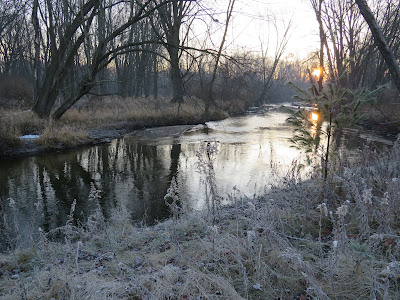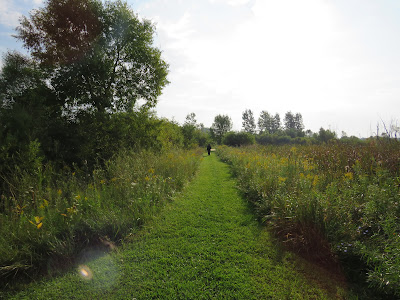In 1926, when George Beck of Ithaca learned that one of the last stands of White Pine in Gratiot County was going to be cut down, he called on local lumberjacks and rivermen to buy a 40-acre tract to preserve these majestic conifers. In 1927, these woodsmen organized an association and raised $3000 to purchase the land that became Lumberjack & Rivermen's Park. Between 2016 and 2018, I was pleased to lead an effort to establish a network of five nature trails within the park. The morning skies are mostly cloudy with temperatures in the upper 20’s and a west wind as I leave the Madison Rd. trailhead where I notice the skeletal remains of a Whitetail deer (likely a decomposed roadkill). Proceeding north, I pause to look at the snow-covered boardwalk and reminisce on its construction, seven years ago. After crossing the board walk where I spot some fox tracks, I come to a small pond covered with ice and Duckweed that surprisingly remains green and alive despite freezing temperatures. Arriving at the footbridge over Mud Creek, I remember completing its construction six years ago as we set two, 30-foot telephone poles across the channel and then built a walkway out of oak lumber, milled from trees in the park. Following the Mud Creek trail north through towering Red and White pines, I circle around, continue west on the Riverview Trail and pause at the edge of the Pine River as its water flows gently past. On a nearby snag, I notice seepage of sap called Slime flux. Also known as wet wood, this seepage is foul-smelling. Slime flux is caused by common surface-inhabiting bacteria or yeast fungi that enter the trunk through wounds. Following a steep bank to the north, I pause at a favorite vista of this watercourse. After crossing the Lumberjack Rd bridge over the river, I follow the Campground Trail south along the bank as the water flows over some boulders. Upon a closer look, I spot a fresh deer carcass stuck on some rocks, perhaps mortally wounded by a hunter’s bullet. Continuing on the Campground trail, I come across some more green vegetation, including fronds of Christmas ferns and a leaf of Wild Yam. I continue south through the vacant campground on an aisle of fallen leaves and a leafless canopy of Oaks and Maples, overhead. Leaving the trail, I once again pause on the river’s edge to watch water from Mud Creek flow into the main channel. After completing the Campground trail, I stop on the Madison Rd. bridge to take one last look at the river as it meanders south toward Riverdale.
Christmas sanctuary
No windows or walls
No carol music playing
Only a Chickadee calls
Christmas sanctuary
Choir of gathering geese
Gratitude for solitude
Planet Earth at peace
Christmas sanctuary
No ringing silver bells
Early morning hike
Mother Nature dwells
D. DeGraaf















